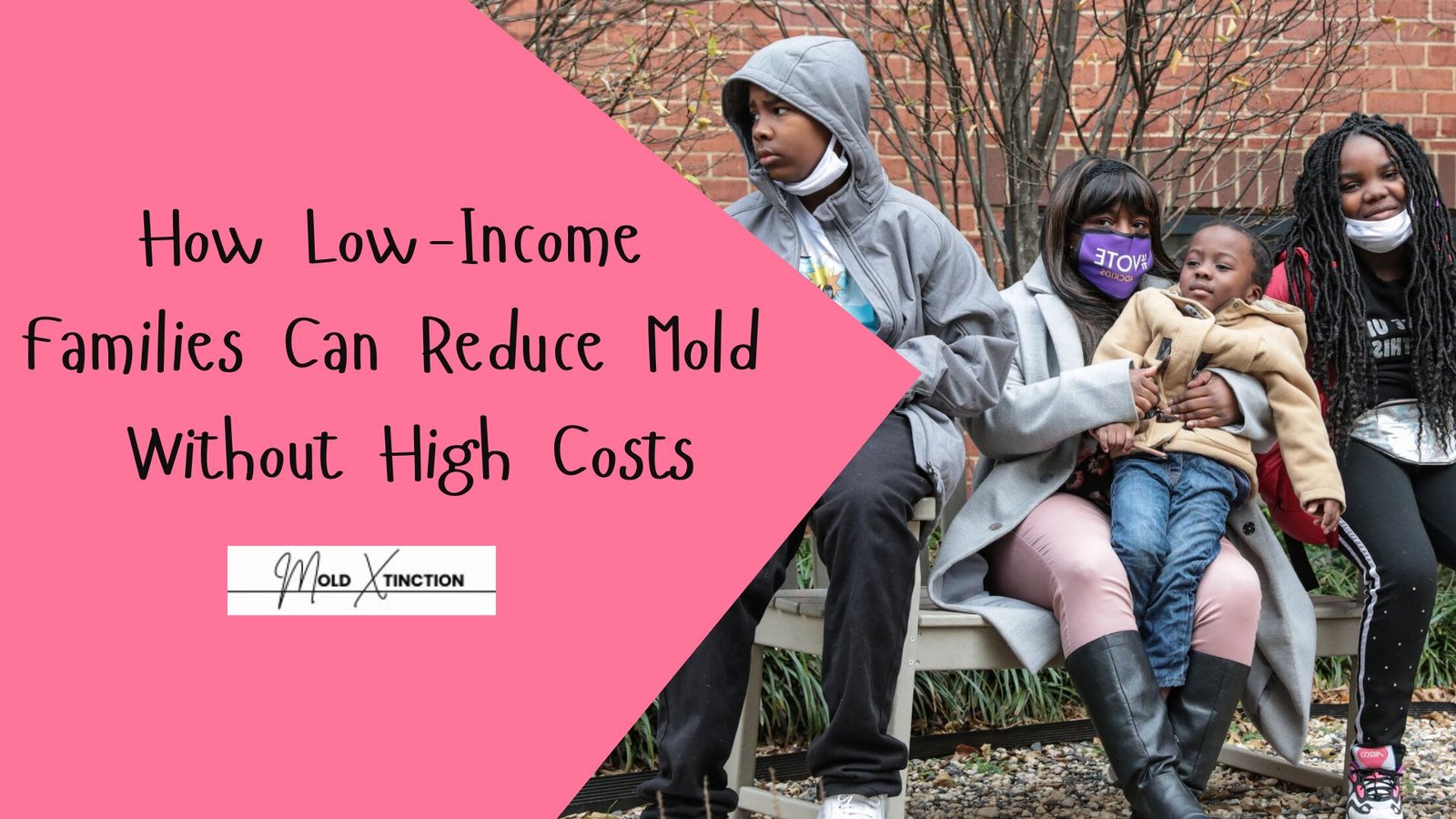Do you know how low-income families can reduce mold without high costs? First is by making your home dry and many other steps, as explained on this page.
Low-income families find it hard to remove mold because hiring professional mold removal experts is too expensive.
Cleaning of molds requires special cleaning tools and supplies so that they can be cleaned thoroughly and safely.
Surveillance takes time, too, i.e., the experts inspect the house to look for hidden molds. In certain situations, molds are already present in walls or beneath floors, and because of this, it is quite hard to eliminate the molds.
This is even more so because molds are toxic, and the experts are guided by the rules to make sure that individuals do not incur the risks of exposure to the mold spores, which are harmful.
Whether it is the cause of the mold, i.e., leaks or water damage, that needs to be corrected, and which adds to the cost. These may not be affordable to low-income families.
The good news is that there are many easy and affordable ways to minimize mold in the house.
This article will show how low-income families can minimize mold without spending too much. We will provide simple steps, points to remember, and when to seek the help of a mold removal service.
What's In This Article
ToggleHow Low-Income Families Can Reduce Mold Without High Costs

Mold reduction doesn’t have to be expensive. It’s not hard and expensive to reduce mould in your home.
Here are some simple steps:
1. Make Your Home Dry
Mold needs water to grow. When your house is dry this prevents the growth and spread of mold. Among other things, fixing any leaks as soon as possible is one of the most important things you can do. When there’s water dripping or water pooling, check if there’s a leaking pipe, tap or roof and fix it as soon as possible. Small leaks don’t always need a specialist, sometimes the dusting of the tape or sealant available in the local store is enough to temporarily stop the leak or even to completely eliminate it.
Also, don’t sweep the water spillage immediately. When cooking, bathing or cleaning up, any water left behind on the floor or surfaces can contribute to the growth of mould hence dry the surfaces using a cloth or a mop. When the floor gets wet due to any kind of water overflow, drying is very important. The more water stays, the more likely mold will occur. The first thing to prevent mold establishment is to keep your home dry.
2. Let Air Circulate Properly
Proper air flow can prevent mold from growing since it dries up wet spots in your house. The fresh air that comes in when you open your windows and doors regularly can take care of the damp air that escapes. A little wind can do a lot in removing moisture. If you have a fan, always turn it on to provide air circulation; especially in rooms like bathrooms and kitchens where water is present.
Don’t pile up clothes, boxes or furniture against the walls since it blocks the air flow and forms dark and humid areas which mold loves. To prevent mold from growing in hidden areas, it’s best that your house is well ventilated and not cluttered. When air moves freely around your house, then you keep your family healthier and your house fresher.
3. Use Natural Mold Removers
Mold doesn’t need you to use expensive chemicals to kill it. You can remove mold in your house safely and cheaply using a lot of natural household items.
White vinegar is very effective. Vinegar can be sprayed or wiped on moldy areas. Let it stay there for about an hour then clean it up with a cloth. Vinegar kills most molds and prevents them from growing back fast.
Or you can use baking soda. Dissolve baking soda in water to get a thick paste. Use the paste on the stain of mold and clean using a sponge or a brush. Then wash the area with water. Baking soda will also absorb much of the moisture so the area won’t be favorable for mold.
Lemon juice has natural acid that can remove mold stains and will also give a fresh smell. You can apply lemon juice on moldy areas, wait for some time then clean the area after that.
4. Clean Your House
It has been seen that cleaning regularly prevents the settling of mold spores in your house. Wash regularly fabrics like curtains, bed sheets and clothes as spores sometimes attach themselves to them and spores spread.
Use vacuum cleaner in carpets and floor areas to remove dust and mold spores that may be hiding in them. Wash bathrooms and kitchens properly since those areas are usually humid. Tiles, sinks and walls can be cleaned with natural cleaners to prevent mold.
5. Control Humidity
Humidity is the wetness in the air. When air is very damp mold grows faster. Reduce the humidity in your house with no fuss at low cost.
Charcoal absorbs moisture wonderfully. Put bowls of charcoal in a humid area like the bathroom or basement so you can dry the air.
Salt also dries up moisture. Put small containers of salt in different rooms to absorb dampness and humidity.
DIY moisture absorbers can also be made by putting a small amount of essential oils in baking soda in small cloth bags. Hang these bags in your house to dry it up and to make the air fresh.
What to Do If Mold Keeps Coming Back?
Sometimes no matter what you do mold comes back. This can be due to leaks in the walls, bad ventilation or severe water damage. In such cases do it fast.
- Inspect walls and ceilings: Water stains or soft spots should be checked.
- Mold hunt in secret places: Sometimes mold is inside walls or under floors.
- Big problems: If it’s due to a big leak or flooding try to fix it as soon as possible.
If all your efforts fail to stop mold growth then it’s time to hire a professional mold remediation company. They have the tools and expertise to detect hidden mold and remove it without consequences.
Basic Equipment and Materials For Mold Prevention
No need to spend too much. There are so many things you can buy cheaply or even use at home and this can help:
- Spray bottles: to spray in vinegar or baking soda solutions.
- Old toothbrush or small brush: ideal since they are used to scrub molds off small places.
- Cloth or sponge: to wipe and clean.
- Dehumidifiers: they reduce moisture but are expensive unless you can afford to buy one. Not; use natural means like charcoal or salt instead.
- Fans: a small fan helps in air circulation in humid rooms.
Tips for Families Living in Rental Homes
Mold is a sticky situation when you’re a renter. You can’t fix big problems in your home like drafts or leaks.
Here are some tips:
- Tell your landlord: Report mold and leaks whenever you see them. They have to fix these.
- Use eco cleaners: Use vinegar or baking soda to clean.
- Ventilate: Open your house windows every day
- and save your stuff: For clothes and furniture use plastic sheeting or waterproof boxes.
Put moisture absorbers: Place bowls of charcoal or salt in rooms.
How to Avoid Mold During the Rainy Season
Where it rains regularly or there is too much humidity in the air, molds grow faster because there is moisture everywhere. Here are some tips you can use to reduce dampness in your home so you can keep it mold-free during the wet season:
- Dry clothes outside: Don’t dry clothes inside the house since wet clothes add to the moisture in the air. This increases the moisture and enables the mold to multiply quickly.
- Check and clean gutters and roofs: Clean out your gutters from time to time so that the water can run off from your house. Damp areas where molds will grow may occur if water seeps into the gutters or the roof is broken.
- Cover windows or door: There are times when are rains very heavily, this is one of the times you keep the windows or the door or doors covered so that the rain cannot enter your house, making it wet.
- Clean frequently: Damp surfaces such as walls, floors and window sills should be quickly wiped dry. Molds multiply well in wet surfaces.
- Raise furniture: Raise furniture whenever possible a little bit from the wall. This allows the backflow of air behind them and prevents moisture from getting trapped to allow the growth of molds.
Your home and family can be protected from the powers of mold during this rainy or humid weather by following these simple steps.
When to Call a Professional Mold Remediation Service
Sometimes no matter how hard you try, at some point the mold may get too big to handle. Mold may be hiding behind walls, house floors or air vents and become a health hazard.
The safest option is to call a professional mold remediation service when:
- The area covered by mold is extensive (bigger than 10 square feet).
- Mold comes back every time you clean.
- You find mold growing in unseen areas such as in the walls.
- Family members are suffering from asthma or allergies.
It includes water leaks that cannot be repaired with simple repairs.
Experts have special equipment to locate invisible mold and eliminate it safely. They can also fix mold causes such as poor ventilation or leaks.
Conclusion
Low income families can’t afford to minimize the mold since professional services of mold removal are expensive.
Special tools and materials are needed to safely remove the mold and prevent the mold from coming back and professionals take time to search the whole house to detect the mold deposits which adds to the bill.
Sometimes, mold can be deep into the walls or under the floors; this makes it more challenging and more expensive to clean.
Also mold repairs can be costly because the root cause of the mold such as leaks or water damage usually requires new repairs that adds to the total cost. The total cost can be too much for families with tight budget.
That’s why most of them try to solve the mold problem themselves at a low cost although in some cases it’s even more effective and safer to call a professional.
Helpful Guide: Reasons Why Mold Is Easily Found in Low-Income Neighborhoods


